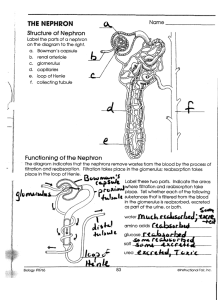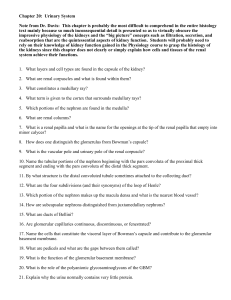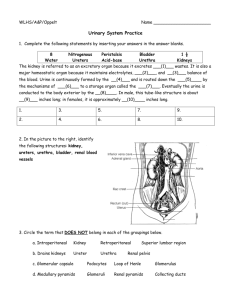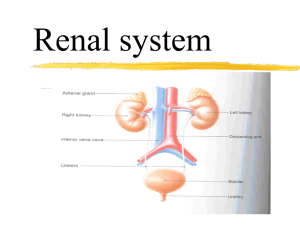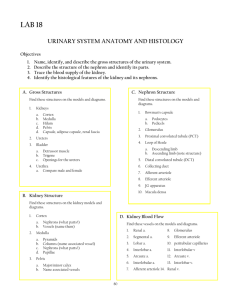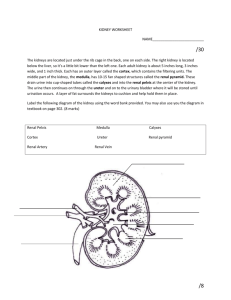nephrology
advertisement
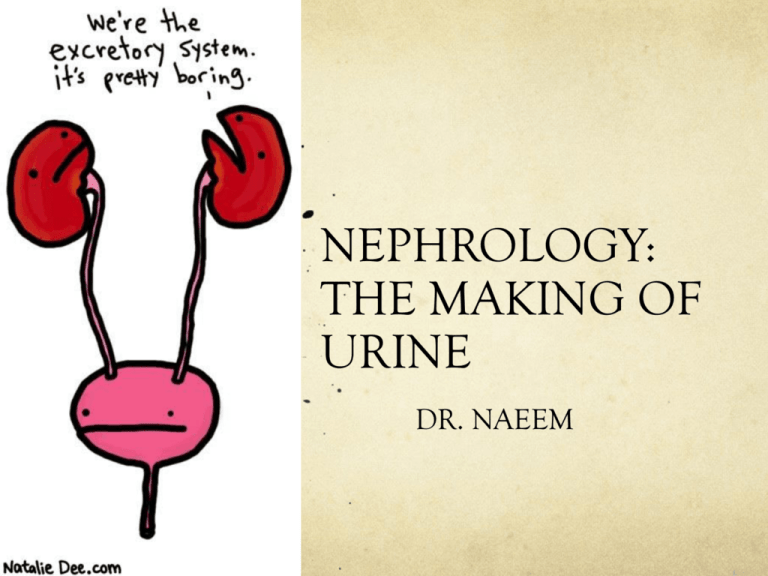
NEPHROLOGY: THE MAKING OF URINE DR. NAEEM Outline Introduction Function Cross Section of the kidney Blood supply Nephron Nephron Physiology INTRODUCTION • The kidneys are a pair of bean shaped organs found along the posterior wall of the abdominal cavity. • The left kidney is located slightly more superior than the right kidney due to the larger size of the liver on the right side of the body. Function of the kidneys Homeostatic functions Regulation of electrolytes Maintenance of acid-base Regulation of blood pressure Filtration of blood Formation of URINE Production of hormones - calcitriol, erythropoietin and the enzyme renin. Blood Supply The renal arteries branch directly from the abdominal aorta and enter the kidneys. Once in the kidney, the renal arteries diverge into smaller arterioles. Afferent arterioles carry blood into the renal cortex, where it separated into a bundle of capillaries known as a GLOMERULUS. From the glomerulus, the blood recollects into smaller efferent arterioles that descend into the renal medulla. The efferent arterioles separate into the peritubular capillaries that surround the renal tubules. Next, the peritubular capillaries merge to form veins that merge again to form the large renal vein. From the renal vein, the blood joins the IVC which carries blood back to the heart. Blood Supply cont… Nephrons The actual removal of wastes occurs in tiny units inside the kidneys called nephrons. Each kidney has about a million nephrons. In the nephron, a glomerulus—which is a tiny blood vessel, or capillary—intertwines with a tiny urine-collecting tube called a tubule. The glomerulus acts as a filtering unit, or sieve, and keeps normal proteins and cells in the bloodstream, allowing extra fluid and wastes to pass through. Renal Corpuscle • The renal corpuscle is the initial bloodfiltering component of a nephron. • It consists of 2 structures: the glomerulus and a Bowmans capsule. Renal Corpuscle Continued… The structures of the layers of the Glomerulus determines the permeability. Factors that influence the selectivity are the negative charges on the Basement Membrane , the epithelium and the pore size of the glomeruli. As a result, small ions like Na & K will pass freely while large molecules like proteins, albumin and hemoglobin have no permeability. Renal Corpuscle Continued Basic Filtration unit of the kidney. GFR: Glomerular Filtration Unit Rate at which blood is filtered through all of the golmeruli, and thus the measure of the overall renal function. Proximal Tubule Also known as the Proximal Convoluted Tubule (PCT). A duct system transporting urine from the Bowmans Capsule to the Loop of Henle. 65-80% of the filtrate is reabsorbed in the PCT. Promixal Tubule Continued… Substance Reabsorbed % of Filtrate Na & H2O ~66% Glucose& amino acids ~100% Potassium ~65% Urea ~50% Phosphate ~80% A summary of the reabsorption along the proximal tubule: Na: Diffusion through ion channels followed by water and Cl or Cotransported with glucose or amino acids. K: Potassium is absorbed mainly by the paracellular route with water via osmosis. Na/K ATPase is pumping 2 K back into the epithelial cells & K is then cleared from the cells using a co-transporter with chlorine. Urea: 50% of filtered urea is reabsorbed in the proximal tubule. However the concentration of urea actually increases thanks to the reabsorption of 70% of the filtered water in the same portion of the nephron. Glucose: Reabsorption of glucose can only occur in the proximal tubule and occurs regardless of the concentration gradient as it is completed via secondary active transport. It is reabsorbed using a co-transported with sodium.secondary active transport. It is reabsorbed using Na. H Secretion/HCO3 Reabsorption: • The secretion of H+ in this section of the nephron is mainly a result of the Na+/H+ exchanger. Energy for it provided by Na/K ATPase. Loop of Henle Is the part of the nephron that connects the proximal convoluted tubule (PCT) to the distal convoluted tubule (DCT). The main function of the Loop of Henle is to maintain a concentration gradient. Loop of Henle Continued… Is divided into 4 parts. Thin descending limb of the loop of Henle. Thin ascending limb of loop of Henle Thick ascending limb Cortical thick ascending limb Loop of Henle Continued… Loop of Henle Continued… Overall the loop of Henle reabsorbs around 25% of filtered ions and 20% of the filtered water in a normal kidney. These ions are mostly Na Cl K Ca HCO3. Distal Convoluted Tubule The distal convoluted tubule (DCT) is a portion of kidney nephron between the loop of Henle and the collecting duct system. Functions: Reabsorbs Na+ ions through coupled secretion of H+ or K+ ions into the tubular fluid via aldosterone. By acidifying the urine the distal convoluted tubule plays an important role in acid-base balance. Normally is relatively impermeable to water. However in the presence of antidiuretic hormone (ADH) its permeability to water increases permitting concentration of the urine. Secretes ammonium ions and some drugs. Forms part of the juxtaglomerular apparatus. Hemodynamic regulation via macula densa and renin Electrolyte homeostasis via Calcium reabsorption Distal Convoluted Tubule cont… On the apical surface (lumen side), the DCT cells have a Na/CL cotransporter and are permeable to Ca. On the basolateral surface (blood), there are several other pumps for Ca, Na & K. Distal Convoluted Tubule cont… Sodium and potassium levels are controlled by secreting K+ and absorbing Na+. Na absorption by the distal tubule is mediated by the hormone aldosterone. Aldosterone increases Na reabsorption. The DCT also participates in Calcium regulation by reabsorbing Ca in response to the Parathyroid hormone (PTH). Collecting Duct Is the final portion in the nephron. The filtrate travels from the Distal Convoluted Tubule, through the collecting duct and into the ureter. It participates in electrolyte and fluid balance through reabsorption and excretion. These processes are regulated by the hormones aldosterone and antidiuretic hormone (ADH). In humans, the system accounts for 4–5% of the kidney's reabsorption of sodium and 5% of the kidneys reabsorption of water. Collecting duct cont… The wide variation in water reabsorption levels for the collecting duct system reflects its dependence on hormonal activation. The collecting ducts are largely impermeable to water without the presence of antidiuretic hormone (ADH or vasopressin). In the absence of ADH, water in the renal filtrate is left alone to enter the urine, promoting diuresis. When ADH is present, aquaporis allow for the absorption of water, thereby inhibiting diuresis. URINE Urine – is the sterile liquid of the body secreted by the kidneys through a process called urination and excreted through the urethra. Color, odor, pH, presence/absence of blood, turbidity & volume are all important aspects of the urine. THE END! QUESTIONS??


